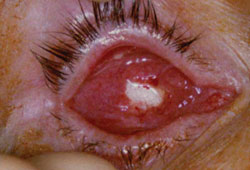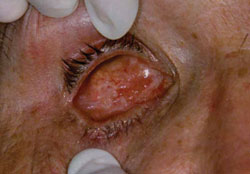Posterior auricular muscle complex graft can be used for ocular implants
Good results have been obtained with this technique when used to wrap an implant at the time of enucleation or to repair an exposed implant.
Introduction
 Thomas John |
Optimal cosmetic reconstruction can often be achieved with the use of a hydroxyapatite ocular implant. It has a lower rate of infection and implant extrusion as compared with other implants. These implants are made up of calcium phosphate, a normal constituent of bone. The porous configuration allows for fibrovascular tissue ingrowth and implant integration into orbital tissues. A hydroxyapatite ocular implant does not react like a foreign body, resists extrusion and migration, appears to be relatively resistant to infection, and can be used as a direct motility implant after orbital tissue integration. However, any exposure of the implant may be a potential setting for infection. Hence, optimal coverage of the implant is imperative. In this article, Drs. Naugle and Fry describe a useful surgical method of using posterior auricular muscle complex graft for the surgical management of hydroxyapatite ocular implant exposure.
– Thomas John, MD
OSN Surgical Maneuvers
Editor
 Thomas C. Naugle |
 Constance L. Fry |
The posterior auricular muscle complex graft is excellent tissue to repair exposures of hydroxyapatite ocular implants in the anophthalmic socket. Failure to cover an exposed hydroxyapatite implant can result in orbital infection.
In 1999, Naugle and colleagues first described the good results achievable using the posterior auricular muscle complex graft (PAMCG) to wrap the initial ocular implant at the time of enucleation. In our hands, the PAMCG wrapping of the initial implant has been used by multiple surgeons for more than 10 years in more than 250 patients, with only two patients developing exposure (0.8%); none of the exposures occurred after modifying the harvest site to the PAMCG overlying the mastoid. This compares favorably with the recent exposure rates (1% to 10%) quoted in the literature for other techniques of wrapping hydroxyapatite (HA) implants.
In 2004, the variable anatomy of the seven muscular structures contributing to the PAMCG was described in detail by Guerra and colleagues. This tissue graft is easily accessible to those operating in the periorbital region and allows for developing a strong autogenous barrier graft over the exposed ocular implant.
We have used the PAMCG for repairing exposed HA implants in five patients who had previously undergone enucleation. The first two patients were treated early in our experience, during the first 5 years; each had a small 3-mm area of exposure (Figure 1) that was easily repaired by utilizing the thicker PAMCG overlying the mastoid region. As a result, we modified the PAMCG technique. Initially, we had harvested the graft along the posterior aspect of the pinna, sometimes including the PAMCG overlying the mastoid; now, we harvest the thicker PAMCG primarily overlying the mastoid to avoid exposure, as this portion of the muscle complex has more tensile strength. The remaining patients were referred at the time of the exposure. Each had a PAMCG placed for secondary exposure; the primary wrapping of the implant had not been with the PAMCG. Two patients had a defect of 10 mm, and one patient had a 12-mm area of exposure. All patients have had an excellent result, and no further exposures were noted in these patients.
Technique
Either general anesthesia or sedation with local infiltration (1% lidocaine with epinephrine for general anesthesia and 2% for intravenous sedation) may be utilized. After the lidocaine with epinephrine 1:100,000 is injected underneath the conjunctiva and Tenon’s capsule, a sharp pointed 15° blade is utilized to clean the exposed implant surface and separate Tenon’s capsule and the overlying conjunctiva for a diameter of up to 22 mm, depending on the size of the defect. Steven scissors further dissect the tissue from the underlying HA implant. After this “bed” has been formed, a PAMCG is harvested.
Attention is directed to the postauricular area, where a line is marked with a marking pen at the junction of the pinna and the mastoid. A larger graft can be harvested from the auricular muscle complex tissue overlying the pinna. The tensile strength of the muscle overlying the pinna does not seem to be as great as that of the portion overlying the mastoid. Accordingly, the tissue overlying the mastoid may be preferable for treating implant exposure.
The ear is reflected for better exposure, utilizing two 4-0 silk traction sutures or perforating towel clips. The retroauricular area has been pre-injected with local anesthetic, and time has been allotted for hemostasis, as this area is highly vascular. An incision is made with a No. 15 Bard-Parker blade along the skin marking line and into the posterior portion of the conchal bowl. A dermal flap is constructed at a depth between 1 mm and 4 mm, depending on the thickness required (Figure 2). A thicker graft is harvested when there is some degree of enophthalmos. Periosteum overlying the mastoid may be incorporated into the graft if desired. The size of the graft to be harvested will be dictated by the size of the defect. Typically, the graft should be overlapped by conjunctiva and Tenon’s capsule by approximately 3 mm to 5 mm. Thus, for a 10-mm defect, a typical graft would be 16 mm to 20 mm by 16 mm to 20 mm to allow for a 3 mm to 5 mm overlap of tissue.
 Figure 1. Central area of exposure of an HA implant after enucleation. The referring physician had unsuccessfully used buccal mucosa to repair the dehiscence. |
 Figure 2. Harvesting the PAMCG over the mastoid region (digitally enhanced). Arrow indicates the PAMCG. |
 Figure 3. Insertion of the PAMCG overlying the exposed area of the implant with the edges of the graft inserted underneath the existing edges of the Tenon’s capsule and conjunctiva. |
 Figure 4. Final healed socket at 5 months postop showing good vascularization where prior exposure was present. Images: Fry CL |
The inner portion of the posterior auricular muscle is left intact to prevent detachment of the pinna. After the graft is harvested, meticulous hemostasis is accomplished with monopolar cautery. The retroauricular incision is then closed with interrupted 3-0 Vicryl or 3-0 chromic gut sutures. The graft is trimmed to the desired thickness and diameter. The graft is then placed underneath Tenon’s capsule and conjunctiva and secured with multiple interrupted 5-0 Vicryl sutures (Figure 3). Oral antibiotics are used for 1 week postoperatively, and topical antibiotics are used in the socket and along the ear sutures for 2 weeks. Within 2 weeks, the conjunctiva migrates over the retroauricular complex graft, resulting in a well-epithelialized socket (Figure 4). Similarly, a nice postoperative cosmetic result is achieved behind the ear, with the incision in the retroauricular area at the junction of the pinna and mastoid. Subsequently, a prosthesis is fit in 6 weeks.
Summary
In summary, the retroauricular complex graft with or without periosteum is useful in the repair of exposed HA ocular implants with good results. The technique varies only from the primary wrapping of implants post-enucleation in the method of securing the graft over the exposed HA implant and that the conjunctiva is allowed to migrate over the graft. Since utilizing the PAMCG overlying the mastoid, we have not had any further episodes of exposure in a large number of cases.
We prefer the postauricular muscle complex graft to cover implant exposures over other techniques utilized, such as banked sclera, pericranial grafts or synthetic tissue. The PAMCG is autogenous and does not carry the risk of prion transmission or scleral melt. Surgical access to harvest the graft is easier than a pericranial graft. Most surgeons performing enucleation are unfamiliar with harvesting a pericranial graft. We have seen a visible scar and hair loss overlying the harvest site with scalp incisions. Additionally, this procedure does not require the additional cost that is incurred by the use of banked or synthetic implant material.
Harvesting the PAMCG may be done rapidly and is easily reproducible with good results. Use of the PAMCG obtained from the mastoid area has precluded the need for implant exposure repair in our experience. We have also used this tissue to wrap gold eyelid weights and as a spacer graft in cases of extensive scarring with eyelid retraction, ptosis overcorrection and anophthalmic enophthalmos.
References:
- Guerra AB, Metzinger SE, Metzinger RC, et al. Variability of the postauricular muscle complex: analysis of 40 hemicadaver dissections. Arch Facial Plast Surg. 2004;6(5):342-347.
- Heckmann JG, Lang CJ, Petruch F, et al. Transmission of Creutzfeldt-Jakob disease via a corneal transplant. J Neurol Neurosurg Psychiatry. 1997;63(3):388-390.
- Liao SL, Kao SC, Tseng JH, Lin LL. Surgical coverage of exposed hydroxyapatite implant with retroauricular myoperiosteal graft. Br J Ophthalmol. 2005;89(1):92-95.
- Naugle TC Jr, Lee AM, Haik BG, Callahan MA. Wrapping hydroxyapatite orbital implants with posterior auricular muscle complex grafts. Am J Ophthalmol. 1999;128(4):495-501.
- Constance L. Fry, MD, can be reached at the University of Texas Health Science Center at San Antonio, 7703 Floyd Curl Drive, MC 6230, San Antonio, TX 78229-3900; 210-567-8421, fax: 210-567-8413; e-mail: fryc@uthscsa.edu.

